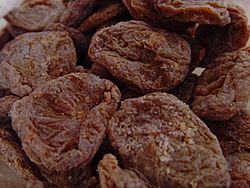Umeboshi facts for kids
'Umeboshi (pronounced oo-meh-boh-shee) are a special kind of pickled fruit from Japan. The word "umeboshi" means 'dried ume in Japanese. These fruits are often called 'Japanese plums' or 'preserved plums', but they are actually more like an apricot than a plum.
Umeboshi are a very popular type of Japanese tsukemono, which means 'pickled thing'. They are usually super sour and salty. But don't worry, you can also find sweeter umeboshi made with honey! People often eat them as a side dish with rice or inside rice balls called onigiri for breakfast and lunch. Sometimes, they are even cooked for dinner.
Contents
What Umeboshi Look Like and Taste Like
Umeboshi are usually round. They can be smooth or have lots of wrinkles. Most umeboshi taste very salty and super sour. This is because they have a lot of something called citric acid. But, as we mentioned, you can also find sweeter kinds.
The middle part of Wakayama Prefecture in Japan is famous for its amazing ume fruits and umeboshi. A town there called Minabe, Wakayama grows more ume and makes more umeboshi than any other place in Japan!
How Umeboshi Are Made
Traditionally, umeboshi are made when ume fruits are ripe, usually around June. The fruits are put into barrels with a lot of salt – about 20% of the fruit's weight. The salt pulls out the juice from the ume, and the fruits then soak in this salty liquid for about two weeks. This salty, sour liquid is called umezu. It's sometimes called 'ume vinegar', but it's not a true vinegar.
Many umeboshi you buy in stores are made less salty first. Then, they are soaked again in a special liquid to give them more flavor. Sometimes, they are dyed red using a purple herb called akajiso. They can also be flavored with things like katsuobushi (dried fish flakes) or kombu (seaweed). Some are even sweetened with honey. Because these flavored umeboshi have less salt (3% to 15%), they often have something added to keep them fresh longer. This can be natural, like vinegar, or artificial.
How People Eat Umeboshi
Umeboshi are usually eaten in small amounts with rice to add a burst of flavor. They are also a common ingredient in onigiri, which are rice balls wrapped in seaweed called nori. You can also find them in makizushi (sushi rolls). For sushi, people might use umeboshi that have had their pits removed, or a cheaper umeboshi paste. Often, they are mixed with fresh green perilla leaves.
A traditional Japanese home remedy for colds and flus is okayu (a type of rice porridge) with umeboshi. Another popular dish is ume chazuke, which is rice with green tea poured over it, topped with umeboshi.
Long ago, samurai warriors valued umeboshi. They believed it helped them fight tiredness during battles. This is because of the salt and citric acid in umeboshi. The salt, citric acid, and other natural parts of umeboshi also help stop germs from growing. This means they can help keep food fresh and prevent tummy problems caused by bacteria.
Umeboshi are also used in cooking to make dishes taste better and look nicer. They can even be served with a drink called shochu and hot water.
In Japan, eating umeboshi as a snack is common. It's a bit like the saying "an apple a day keeps the doctor away" in English. Kids' candy shops sometimes sell karikari ume, which are crunchy pickled ume that come in a package, and dried umeboshi.
Similar Foods Around the World
The way umeboshi are pickled is similar to how other preserved foods are made in places like China, Vietnam, and Korea.
In Vietnam, a very similar pickled ume fruit is called xí muội or ô mai.
In the Philippines, a similar food is called kiamoy or tsampoy. These are usually drier. Kiamoy and tsampoy were brought to Mexico a long time ago. In Mexico, a similar food is called chamoy. It's usually made from apricot, ume, or tamarind, mixed with salt and dry chili.
In countries like India and Nepal, a fruit called amla (Indian gooseberry) is prepared in a similar way. Sometimes, it's even made with sugar syrup.
In South Africa, a similar dried fruit is called mebos. This name might have come from the Japanese word "umeboshi" through Dutch traders. Mebos is usually made from apricots and is salty and sour. But other sweet versions made from different fruits are also called mebos.
See also
 In Spanish: Umeboshi para niños
In Spanish: Umeboshi para niños





